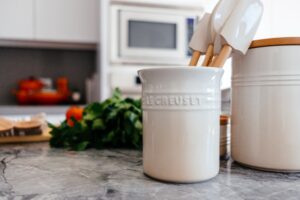Looking for the best non-toxic cookware out there? You’re not alone! With concerns about harmful chemicals leaching into our food, it’s important to find cookware that is both safe and high-quality. In this article, we will explore the different types of non-toxic cookware available, from ceramic to stainless steel, and highlight their pros and cons. By the end, you’ll have a better understanding of what to look for in your quest for healthy cooking options.

This image is property of images.unsplash.com.
Get The Best Non Toxic Cookware
Understanding Non-Toxic Cookware
What does non-toxic cookware mean?
When we talk about non-toxic cookware, we refer to cookware that does not release harmful chemicals or toxins into our food when cooking. Traditional cookware can sometimes leach harmful substances such as lead, cadmium, and PFOA (perfluorooctanoic acid) into our meals, which can have long-term health effects. Non-toxic cookware, on the other hand, is made from materials that are free from these harmful substances, ensuring that our food remains safe and healthy for consumption.
Why is it important to use non-toxic cookware?
Using non-toxic cookware is crucial for maintaining our overall well-being. The chemicals and toxins released from conventional cookware can be absorbed into our bodies through the food we eat. Over time, exposure to these substances can lead to serious health issues, including organ damage, hormonal imbalances, and even certain types of cancers. By switching to non-toxic cookware, we can significantly reduce our exposure to these harmful substances, allowing us to enjoy delicious meals without compromising our health.
Types of Non-Toxic Cookware
Ceramic Cookware
Ceramic cookware is a popular choice when it comes to non-toxic options. Made from natural materials such as clay and sand, ceramic cookware is free from harmful chemicals and heavy metals. It is known for its ability to distribute heat evenly, preventing hot spots and ensuring that your food cooks evenly. Ceramic cookware is also non-reactive, meaning it does not leach any harmful substances into your food. Additionally, it is scratch-resistant and easy to clean, making it a versatile option for your kitchen.
Cast Iron Cookware
Cast iron cookware has been used for centuries, and for good reason. This type of cookware is known for its excellent heat retention and distribution properties. Cast iron is entirely chemical-free and is a great option for those looking for non-toxic cookware. It adds a small amount of dietary iron to your food, which can be beneficial for individuals with iron deficiencies. However, it’s important to note that cast iron requires proper seasoning and maintenance to prevent rust and prolong its lifespan.
Stainless Steel Cookware
Stainless steel cookware is another excellent choice for non-toxic cooking. It is made of a combination of metals like chromium, nickel, and iron, which are non-reactive and do not release any harmful substances into your food. Stainless steel cookware is known for its durability and resistance to corrosion, making it a long-lasting investment for your kitchen. It also has excellent heat distribution properties, ensuring that your food is cooked evenly. However, stainless steel cookware may not provide non-stick capabilities without the addition of a non-toxic coating.
Purchase Non Toxic Cookware Now
Advantages and Disadvantages of Ceramic Cookware
Advantages
Ceramic cookware offers several advantages. Firstly, it is entirely non-toxic, ensuring that no harmful substances leach into your food. It is also non-reactive, meaning it won’t alter the taste or smell of your dishes. Ceramic cookware distributes heat evenly, preventing hot spots and allowing for consistent cooking. Its scratch-resistant surface makes it durable and long-lasting. Additionally, ceramic cookware is generally easy to clean and does not require any special maintenance.
Disadvantages
One of the main disadvantages of ceramic cookware is that it can be prone to chipping or cracking if mishandled or dropped. Extreme temperature changes can also cause ceramic cookware to crack. Additionally, some ceramic coatings may not be as durable and may wear off over time. It’s important to choose high-quality ceramic cookware to ensure its longevity and performance.
Advantages and Disadvantages of Cast Iron Cookware
Advantages
Cast iron cookware offers several advantages. Firstly, it is entirely non-toxic and does not release any harmful chemicals or substances into your food. It is known for its excellent heat retention, allowing for even cooking and consistent results. Cast iron cookware is highly durable and can last for generations if properly cared for. It also adds a small amount of dietary iron to your food, which can be beneficial for individuals with iron deficiencies.
Disadvantages
One of the main disadvantages of cast iron cookware is its weight. Cast iron is considerably heavier than other types of cookware, which can make it difficult to maneuver. Additionally, cast iron requires proper seasoning and maintenance to prevent rust. It is not dishwasher safe and should be hand-washed and dried thoroughly to avoid any moisture-related issues. Lastly, acidic foods may react with the iron surface, altering the taste and color of the dish.

This image is property of images.unsplash.com.
Advantages and Disadvantages of Stainless Steel Cookware
Advantages
Stainless steel cookware offers several advantages. Firstly, it is non-toxic and does not release any harmful substances into your food. It is highly durable and resistant to corrosion, making it a long-lasting investment. Stainless steel cookware heats up quickly and evenly, ensuring consistent cooking results. It is also dishwasher safe, making it convenient for busy households. Additionally, it has a sleek and modern appearance that fits well in any kitchen.
Disadvantages
One of the main disadvantages of stainless steel cookware is that it is not naturally non-stick. This means that you may need to use more oil or butter when cooking to prevent food from sticking to the surface. However, some stainless steel cookware comes with a non-toxic non-stick coating for added convenience. Stainless steel cookware can also be more expensive compared to other types of cookware, depending on the brand and quality.
Non-Toxic Coatings for Cookware
Ceramic Coating
Ceramic coating is a popular choice for non-toxic cookware. It is made from natural materials and provides a non-stick surface without the use of harmful chemicals like PFOA or PFAS (perfluoroalkyl substances). Ceramic coatings are resistant to scratches and are generally safe to use with metal utensils. They also offer easy cleanup and come in a variety of vibrant colors.
Enamel Coating
Enamel coating is another non-toxic option for cookware. It consists of a glass-like coating that is fused to the metal surface. Enamel-coated cookware is highly resistant to staining and rust. It is also non-reactive, making it safe for cooking acidic foods. However, enamel-coated cookware should be handled with care to avoid chipping or cracking the coating.
Glass Coating
Glass coating is a newer option for non-toxic cookware. It provides a smooth and non-stick surface without the use of chemicals. Glass coatings are resistant to scratches and can withstand higher temperatures than traditional non-stick coatings. They are also easy to clean and offer excellent heat conductivity. However, glass-coated cookware may be more prone to chipping or cracking if mishandled.

This image is property of images.unsplash.com.
Top Brands for Non-Toxic Cookware
GreenPan
GreenPan is a well-known brand that specializes in non-toxic ceramic cookware. Their cookware is free from harmful substances and features a durable ceramic non-stick coating. GreenPan offers a wide range of products, including frying pans, saucepans, and grill pans, making it easy to find the right cookware for your needs.
Caraway
Caraway is a popular brand that offers non-toxic ceramic-coated cookware. Their cookware is free from harmful chemicals and features a ceramic non-stick coating that is scratch-resistant. Caraway’s cookware sets include essential pots and pans, as well as lids and storage options, to meet all your cooking needs.
Xtrema
Xtrema is a leading brand for non-toxic ceramic cookware. Their cookware is made from natural materials and features a high-gloss ceramic coating. Xtrema’s cookware is versatile and can be used on stovetops, ovens, and even grills. They offer a wide range of cookware options, including saucepans, skillets, and bakeware.
Made In
Made In is a reputable brand that offers non-toxic stainless steel cookware. Their cookware is crafted from premium materials and features a 5-ply construction for optimal heat distribution. Made In offers a wide range of cookware options, including saucepans, sauté pans, and stockpots, ensuring you have everything you need for your cooking adventures.
How to Choose Non-Toxic Cookware
Material Composition
When choosing non-toxic cookware, consider the material composition. Look for cookware made from natural materials such as ceramic, cast iron, or stainless steel. Avoid materials that may contain harmful substances, such as non-stick coatings that contain PFOA or PFAS.
Non-Stick Coating
If you prefer non-stick capabilities, opt for non-toxic coatings such as ceramic or enamel. These coatings provide a smooth surface without the use of harmful chemicals. Ensure that the coating is scratch-resistant and durable for long-lasting performance.
Heat Conductivity
Consider the heat conductivity of the cookware material. Ceramic and cast iron cookware are known for their excellent heat retention and distribution properties, while stainless steel may require additional layers or coatings for optimal heat conductivity.
Durability
Choose cookware that is durable and built to last. Look for high-quality materials and construction. Read reviews and consider brands known for their durability and longevity.
Price Range
Consider your budget when selecting non-toxic cookware. While some high-end options may be more expensive, there are also affordable options available. Compare prices and features to find the cookware that suits your needs and budget.
Maintenance and Care for Non-Toxic Cookware
Cleaning Tips
For non-toxic cookware, it is generally best to follow the manufacturer’s cleaning instructions. However, most non-toxic cookware can be hand-washed with mild soap and warm water. Avoid using abrasive cleaners or harsh scouring pads that can damage the surface. Additionally, avoid soaking the cookware for extended periods, as this can affect the non-stick properties.
Avoiding Scratches
To prevent scratches on non-toxic cookware, use non-metal utensils such as silicone or wooden utensils. Avoid using sharp knives directly on the cooking surface and stacking cookware to prevent scratches or dents.
Seasoning Cast Iron Cookware
To maintain cast iron cookware, proper seasoning is essential. Seasoning helps create a non-stick surface and prevents rust. To season cast iron, coat the surface with a thin layer of cooking oil and bake it in the oven at a low temperature. Repeat this process periodically to keep the surface well-seasoned.
Conclusion
Choosing non-toxic cookware is a step towards a healthier and safer cooking experience. Ceramic, cast iron, and stainless steel cookware are excellent options that are free from harmful chemicals and toxins. Consider factors such as material composition, non-stick coating, heat conductivity, durability, and price range when selecting non-toxic cookware. Remember to take care of your cookware through proper cleaning, avoiding scratches, and seasoning when necessary. By prioritizing non-toxic cookware, you can enjoy delicious meals with the peace of mind that your health is safeguarded.

